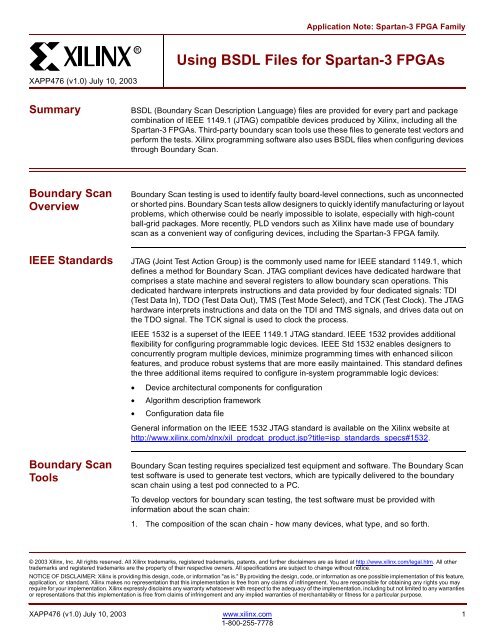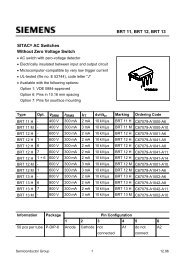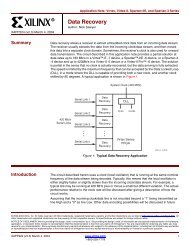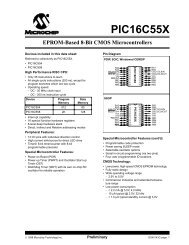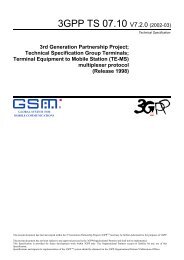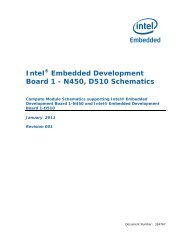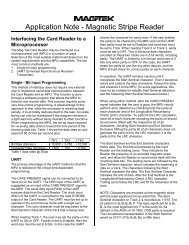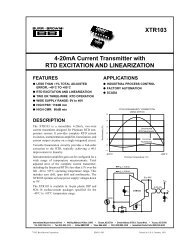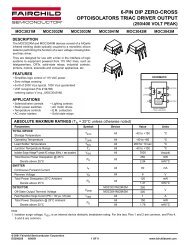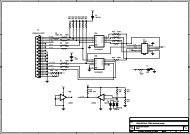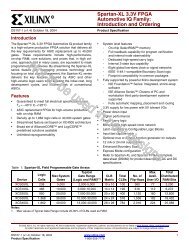Xilinx Using BSDL Files for Spartan-3 FPGAs application note ...
Xilinx Using BSDL Files for Spartan-3 FPGAs application note ...
Xilinx Using BSDL Files for Spartan-3 FPGAs application note ...
You also want an ePaper? Increase the reach of your titles
YUMPU automatically turns print PDFs into web optimized ePapers that Google loves.
<strong>Using</strong> <strong>BSDL</strong> <strong>Files</strong> <strong>for</strong> <strong>Spartan</strong>-3 <strong>FPGAs</strong>RExample (from the xc3s50_pq208.bsd file):port (GND: linkage bit_vector (1 to 28);CCLK_P104: inout bit;DONE_P103: inout bit;HSWAP_EN_P206: in bit;M0_P55: in bit;M1_P54: in bit;M2_P56: in bit;PROG_B: in bit;TCK: in bit;TDI: in bit;TDO: out bit;TMS: in bit;VCCAUX: linkage bit_vector (1 to 8);VCCINT: linkage bit_vector (1 to 4);VCCO0: linkage bit_vector (1 to 2);IO_P2: inout bit; -- PAD124IO_P3: inout bit; -- PAD1234. Package Pin MappingThe Package Pin Mapping shows how the pads on the device die are wired to the pins onthe device package.Example (from the xc3s50_pq208.bsd file):constant PQ208: PIN_MAP_STRING:="GND:(P1,P8,P14,P25,P30,P41,P47,P53,P59,P66," &"P75,P82,P91,P99,P105,P112,P118,P129,P134,P145," &"P151,P157,P163,P170,P179,P186,P195,P202)," &"CCLK_P104:P104," &"DONE_P103:P103," &"HSWAP_EN_P206:P206," &"M0_P55:P55," &"M1_P54:P54," &"M2_P56:P56," &"PROG_B:P207," &"TCK:P159," &"TDI:P208," &"TDO:P158," &"TMS:P160," &"VCCAUX:(P17,P38,P69,P89,P121,P142,P173,P193)," &"VCCINT:(P70,P88,P174,P192)," &"VCCO0:(P188,P201)," &"IO_P2:P2," &"IO_P3:P3," &5. use statementsThe use statement calls VHDL packages that contain attributes, types, constants, andothers that are referenced in the <strong>BSDL</strong> File.Example (from the xc3s50_pq208.bsd file):use STD_1149_1_1994.all;6. Scan Port IdentificationThe Scan Port Identification identifies the JTAG pins: TDI, TDO, TMS, TCK, and TRST (ifused). TRST is an optional JTAG pin that is not used by <strong>Xilinx</strong> devices.XAPP476 (v1.0) July 10, 2003 www.xilinx.com 31-800-255-7778
R<strong>Using</strong> <strong>BSDL</strong> <strong>Files</strong> <strong>for</strong> <strong>Spartan</strong>-3 <strong>FPGAs</strong>Example (from the xc3s50_pq208.bsd file):attribute TAP_SCAN_IN of TDI : signal is true;attribute TAP_SCAN_MODE of TMS : signal is true;attribute TAP_SCAN_OUT of TDO : signal is true;attribute TAP_SCAN_CLOCK of TCK : signal is (33.0e6, BOTH);7. TAP descriptionThe TAP description provides additional in<strong>for</strong>mation on the device’s JTAG logic. Some ofthis in<strong>for</strong>mation includes the Instruction Register length, Instruction Opcodes, and deviceIDCODE. These characteristics are device specific, and may vary widely from device todevice.Examples (from the xc3s50_pq208.bsd file):attribute COMPLIANCE_PATTERNS of XC3S50_PQ208 : entity is"(PROG_B) (1)";attribute INSTRUCTION_LENGTH of XC3S50_PQ208 : entity is 6;attribute INSTRUCTION_OPCODE of XC3S50_PQ208 : entity is"EXTEST (000000)," &attribute INSTRUCTION_CAPTURE of XC3S50_PQ208 : entity is"XXXX01";attribute IDCODE_REGISTER of XC3S50_PQ208 : entity is"XXXX" & -- version"0001010" & -- family"000001100" & -- array size"00001001001" & -- manufacturer"1"; -- required by 1149.18. Boundary Register descriptionThe Boundary Register description gives the structure of the Boundary Scan cells on thedevice. Each pin on a device may have up to three Boundary Scan cells, each cellconsisting of a register and a latch. Boundary Scan test vectors are loaded into or scannedfrom these registers.Example (from the xc3s50_pq208.bsd file):attribute BOUNDARY_REGISTER of XC3S50_PQ208 : entity is" 0 (BC_2, *, controlr, 1)," &" 1 (BC_2, IO_P161, output3, X, 0, 1, PULL0)," & -- PAD30" 2 (BC_2, IO_P161, input, X)," & -- PAD30<strong>BSDL</strong> File Verification<strong>Xilinx</strong> verification of the supplied <strong>BSDL</strong> files has two levels. Preliminary files are generatedusing an automated, <strong>Xilinx</strong>-standard, <strong>BSDL</strong> generation process. The process is script-basedand extracts in<strong>for</strong>mation directly from the device design files, which fully describe thearchitecture and pinout. The quality of "Preliminary" <strong>BSDL</strong> files is very high, and the syntax isalways tested. <strong>Files</strong> marked "Final" have undergone all the tests <strong>for</strong> syntax and hardwareverification. To guarantee that the <strong>BSDL</strong> files exactly describe the operation of each pin, <strong>Xilinx</strong>uses an independent third-party boundary-scan tool vendor — Intellitech — to verify the actualsilicon against the <strong>BSDL</strong>.<strong>Xilinx</strong> <strong>BSDL</strong> files are checked <strong>for</strong> 1149.1 compliance with the Intellitech Eclipse product using'strict' <strong>BSDL</strong> syntax checking. Every semantic check described in the IEEE 1149.1b-1994 (thestandard <strong>for</strong> <strong>BSDL</strong> syntax) is per<strong>for</strong>med using strict parsing. Test patterns then are generatedfrom the <strong>BSDL</strong> file that include unique tests <strong>for</strong> every I/O pin. Each <strong>Xilinx</strong> device/packagecombination is tested on the Intellitech RCT (Reduced Contact Tester). The test patternsinclude verification of Test-Logic-Reset and TAP controller operation,BYPASS/IDCODE/USERCODE instructions and registers, and pin mapping of the boundaryregister to every input/output/bidir/clock pin and control cell. Finally, each device is tested <strong>for</strong>4 www.xilinx.com XAPP476 (v1.0) July 10, 20031-800-255-7778
<strong>Using</strong> <strong>BSDL</strong> <strong>Files</strong> <strong>for</strong> <strong>Spartan</strong>-3 <strong>FPGAs</strong>R1149.1 compliance after the device is programmed by downloading a design and using theRCT tester to verify post configuration compliance.<strong>Using</strong> <strong>BSDL</strong>Anno <strong>for</strong> Post-Configuration Boundary Scan BehaviorWhenever possible, boundary scan tests should be per<strong>for</strong>med on an unconfigured <strong>Spartan</strong>-3device. Unconfigured devices allow <strong>for</strong> better test coverage, since all I/Os are available <strong>for</strong>bidirectional scan vectors. Boundary Scan tests should be per<strong>for</strong>med after configuration whenconfiguration cannot be prevented and when differential signaling standards are used. If thedifferential signals are located between <strong>Xilinx</strong> devices, both devices can be tested preconfiguration.Each side of the differential pair will behave as a single-ended signal.The <strong>BSDL</strong> files provided by <strong>Xilinx</strong> reflect the Boundary Scan behavior of an unconfigureddevice. After configuration, the boundary scan behavior of a device changes. I/O pins that werebidirectional be<strong>for</strong>e configuration may now be input-only, output-only, bidirectional, orunavailable. Boundary Scan test vectors typically are derived from <strong>BSDL</strong> files, so if boundaryscan tests are going to be per<strong>for</strong>med on a configured <strong>Xilinx</strong> device, the <strong>BSDL</strong> file must bemodified to reflect the device's configured Boundary Scan behavior.The boundary scan architecture changes after the device is configured because the boundaryscan registers sit behind the I/O buffer and sense amplifier. The hardware is arranged in thisway so that the boundary scan logic operates at the I/O standard specified by the design. Thisallows boundary scan testing across the entire range of available I/O standards.Because certain connections between the boundary scan registers and pad may change, theboundary scan architecture is effectively changed when the device is configured. Thesechanges often need to be communicated to the boundary scan tester through a postconfiguration<strong>BSDL</strong> file. If the changes to the boundary scan architecture are not reflected inthe <strong>BSDL</strong> file, boundary scan tests may fail.<strong>Xilinx</strong> offers the <strong>BSDL</strong>Anno utility to automatically modify the <strong>BSDL</strong> file <strong>for</strong> post-configurationtesting. <strong>BSDL</strong>Anno obtains the necessary design in<strong>for</strong>mation from the routed .ncd file andgenerates a <strong>BSDL</strong> file that reflects the post-configuration boundary scan architecture of thedevice.Use the following syntax to generate a post-configuration <strong>BSDL</strong> file with <strong>BSDL</strong>Anno:bsdlanno [options] infile[.ncd] outfile[.bsd]The infile is the routed (post-PAR) NCD design source file <strong>for</strong> the specified design. Theoutfile[.bsd] is the destination <strong>for</strong> the design-specific <strong>BSDL</strong> file. The .bsd extension isoptional. For more details on <strong>BSDL</strong>anno, see Answer 15346 athttp://www.xilinx.com/xlnx/xil_ans_display.jsp?i&getPagePath=15346.SoftwareSupport<strong>Xilinx</strong> offers several tools <strong>for</strong> generating device files and <strong>for</strong> device programming. BoundaryScan test functionality is available from several third-party vendors, as <strong>note</strong>d underConfiguration Solutions on www.xilinx.com.iMPACTiMPACT is a full featured software tool used <strong>for</strong> configuration and programming of all <strong>Xilinx</strong><strong>FPGAs</strong>, CPLDs, and PROMs. It features a series of "wizard" dialogs that easily guide the userthrough the every step of the configuration process. iMPACT supports a host of output file typesincluding SVF. iMPACT configuration software enables users to easily configure all <strong>Xilinx</strong><strong>FPGAs</strong> using three different modes; slave serial, SelectMAP (Slave Parallel), and JTAG IEEE1149.1. iMPACT supports the Parallel Cable IV and MultiPRO cables.iMPACT features a special function in the JTAG mode to test both the operation of the cable andthe robustness of the JTAG chain. The user can test chain operation by instructing iMPACT towrite to and read back from the user code location multiple thousands of times. It then countsXAPP476 (v1.0) July 10, 2003 www.xilinx.com 51-800-255-7778
R<strong>Using</strong> <strong>BSDL</strong> <strong>Files</strong> <strong>for</strong> <strong>Spartan</strong>-3 <strong>FPGAs</strong>the number of errors that occur in this operation. This gives the user the opportunity to evaluatethe relative robustness of the JTAG chain and the susceptibility to noise and other influenceslike board layout.SVF <strong>Files</strong>Serial Vector Format (SVF) is an industry-standard file <strong>for</strong>mat that is used to describe JTAGchain operations in a compact, portable fashion. SVF files capture all of the device specificprogramming in<strong>for</strong>mation within the SVF instructions. SVF files are useful because intricateknowledge of the device is not needed. The capability to create SVF files is included in theiMPACT tool. See the iMPACT User Guide <strong>for</strong> more details.J Drive Engine <strong>for</strong> IEEE 1532 Programming<strong>Xilinx</strong> has developed and introduced the world's first IEEE Std 1532 Programming Engine: JDrive Engine. <strong>Using</strong> this engine and a simple cable connected to the parallel port of any PC,users can easily configure <strong>Xilinx</strong> IEEE Std 1532 compatible PLDs. The designer provides JDrive Engine with the data and 1532 <strong>BSDL</strong> files <strong>for</strong> the device(s) to be programmed using acommand line interface to configure the PLDs in the JTAG chain. For more in<strong>for</strong>mation, seehttp://www.xilinx.com/xlnx/xil_prodcat_systemsolution.jsp?title=isp_jdrivemain_page.<strong>Using</strong> the BSCAN_SPARTAN3 MacroBSCAN_SPARTAN3 provides access to the BSCAN sites on a <strong>Spartan</strong>-3 device. It is used tocreate internal boundary scan chains. The four-pin JTAG interface (TDI, TDO, TCK, and TMS)contains dedicated pins in <strong>Spartan</strong>-3 <strong>FPGAs</strong>. To use normal JTAG <strong>for</strong> boundary scanpurposes, just hook up the JTAG pins to the port and go. The pins on the BSCAN_SPARTAN3symbol do not need to be connected unless those special functions are needed to drive aninternal scan chain.<strong>Spartan</strong>-3 <strong>FPGAs</strong> provide hooks <strong>for</strong> two user-definable scan chains through the USER1 andUSER2 instructions. These instructions may be used to provide access to the user designthrough the JTAG interface. To take advantage of the optional USER1 and USER2 instructions,the designer must instantiate the BSCAN_SPARTAN3 macro in the source code, and wire it tothe user-defined scan chain.RevisionHistoryThe following table shows the revision history <strong>for</strong> this document.Date Version Revision07/10/03 1.0 Initial <strong>Xilinx</strong> release.6 www.xilinx.com XAPP476 (v1.0) July 10, 20031-800-255-7778


